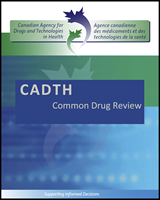Ustekinumab (Stelara)
Common Drug Review
Crohn’s disease is a chronic form of inflammatory bowel disease that can affect any part of the gastrointestinal tract but most commonly affects the ileum, colon, and rectum. Common gastrointestinal symptoms experienced by patients with Crohn’s disease include abdominal pain, rectal bleeding, fatigue, vomiting, diarrhea, perianal disease, weight loss, and bloating.1–3 According to Crohn’s and Colitis Canada, there are approximately 129,000 Canadians living with Crohn’s disease (one in 150 people), and it is estimated that 5,700 new cases of Crohn’s disease are diagnosed each year.1
Ustekinumab (Stelara) is a fully human immunoglobulin G1 kappa monoclonal antibody that binds to the shared p40 subunit of interleukin (IL)-12 and IL-23.4 Ustekinumab is already approved by Health Canada for the treatment of adults with chronic moderate-to-severe plaque psoriasis who are candidates for systemic therapy or phototherapy, and for the treatment of adult patients with active psoriatic arthritis, alone or in combination with methotrexate.4
The current indication under review is for the treatment of adult patients with moderately to severely active Crohn’s disease, who have had an inadequate response with, loss of response to, or intolerance to either immunomodulators or one or more tumour necrosis factor (TNF) alpha antagonists, or have had an inadequate response with, intolerance to, or demonstrated dependence on corticosteroids. The recommended dosage for ustekinumab in the treatment of Crohn’s disease is an initial single intravenous (IV) induction dose based on body weight (approximating 6 mg/kg), followed by a 90 mg subcutaneous (SC) maintenance dose eight weeks later, then one dose every eight weeks thereafter as maintenance treatment. For some patients (e.g., “those with low inflammatory burden,” per the product monograph), an alternative maintenance regimen of ustekinumab 90 mg SC every 12 weeks may be administered at the discretion of the treating physician. Patients who inadequately respond to the 90 mg SC every 12 weeks regimen may be switched to the every eight weeks regimen. Immunomodulators and/or corticosteroids may be continued during treatment with ustekinumab. The product monograph recommends that, in patients who have responded to treatment with ustekinumab, corticosteroids may be reduced or discontinued in accordance with standard of care.4
The objective of this report is to perform a systematic review of the beneficial and harmful effects of ustekinumab in accordance with the Health Canada–approved indication for the treatment of Crohn’s disease. Only Health Canada–approved dosage regimens for ustekinumab for Crohn’s disease were included in this review. Ustekinumab has been previously reviewed through the CADTH Common Drug Review (CDR) for the treatment of plaque psoriasis and psoriatic arthritis.5,6
This review report was prepared by the Canadian Agency for Drugs and Technologies in Health (CADTH). In addition to CADTH staff, the review team included a clinical expert in gastroenterology who provided input on the conduct of the review and the interpretation of findings
The information in this document is intended to help Canadian health care decision-makers, health care professionals, health systems leaders, and policy-makers make well-informed decisions and thereby improve the quality of health care services. While patients and others may access this document, the document is made available for informational purposes only and no representations or warranties are made with respect to its fitness for any particular purpose. The information in this document should not be used as a substitute for professional medical advice or as a substitute for the application of clinical judgment in respect of the care of a particular patient or other professional judgment in any decision-making process. The Canadian Agency for Drugs and Technologies in Health (CADTH) does not endorse any information, drugs, therapies, treatments, products, processes, or services.
While care has been taken to ensure that the information prepared by CADTH in this document is accurate, complete, and up-to-date as at the applicable date the material was first published by CADTH, CADTH does not make any guarantees to that effect. CADTH does not guarantee and is not responsible for the quality, currency, propriety, accuracy, or reasonableness of any statements, information, or conclusions contained in any third-party materials used in preparing this document. The views and opinions of third parties published in this document do not necessarily state or reflect those of CADTH.
CADTH is not responsible for any errors, omissions, injury, loss, or damage arising from or relating to the use (or misuse) of any information, statements, or conclusions contained in or implied by the contents of this document or any of the source materials.
This document may contain links to third-party websites. CADTH does not have control over the content of such sites. Use of third-party sites is governed by the third-party website owners’ own terms and conditions set out for such sites. CADTH does not make any guarantee with respect to any information contained on such third-party sites and CADTH is not responsible for any injury, loss, or damage suffered as a result of using such third-party sites. CADTH has no responsibility for the collection, use, and disclosure of personal information by third-party sites.
Subject to the aforementioned limitations, the views expressed herein are those of CADTH and do not necessarily represent the views of Canada’s federal, provincial, or territorial governments.
This document is prepared and intended for use in the context of the Canadian health care system. The use of this document outside of Canada is done so at the user’s own risk.
This disclaimer and any questions or matters of any nature arising from or relating to the content or use (or misuse) of this document will be governed by and interpreted in accordance with the laws of the Province of Ontario and the laws of Canada applicable therein, and all proceedings shall be subject to the exclusive jurisdiction of the courts of the Province of Ontario, Canada.
Except where otherwise noted, this work is distributed under the terms of a Creative Commons Attribution-NonCommercial-NoDerivatives 4.0 International licence (CC BY-NC-ND), a copy of which is available at http://creativecommons.org/licenses/by-nc-nd/4.0/
